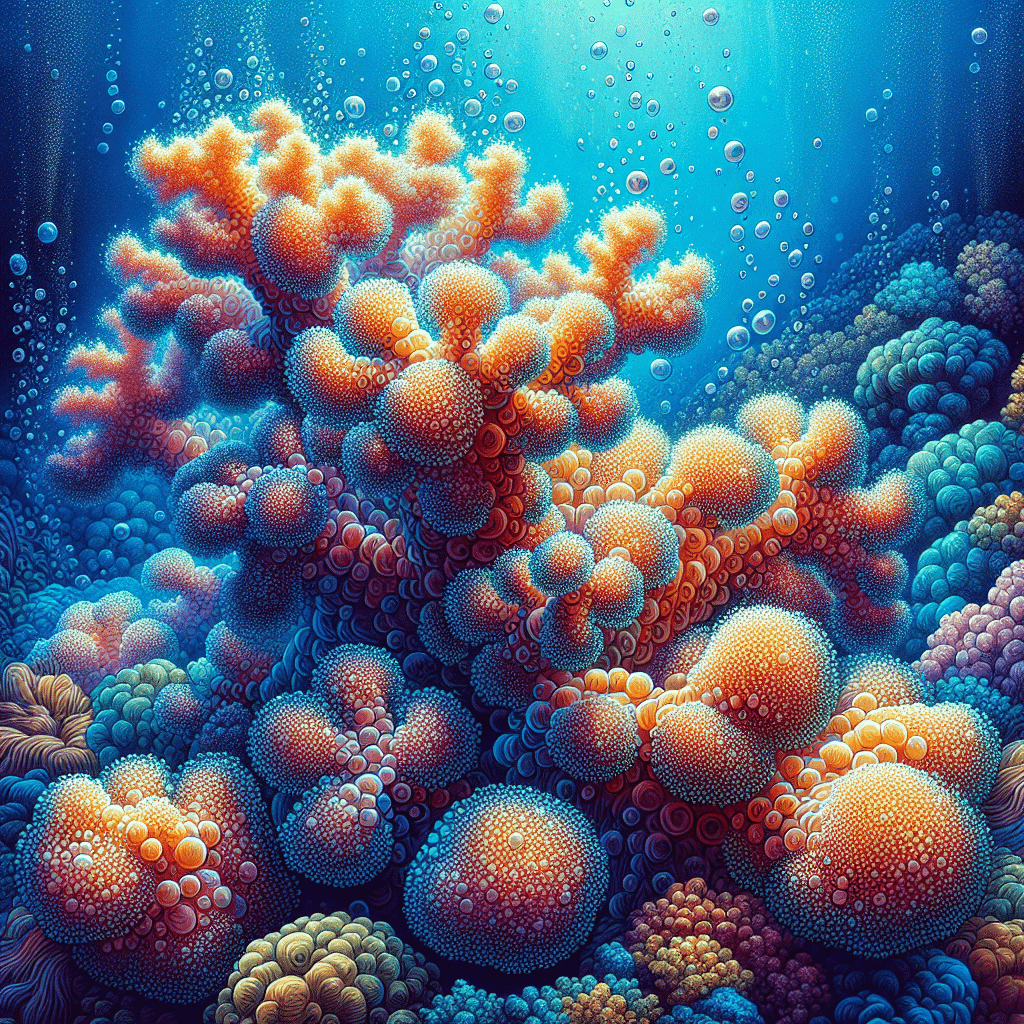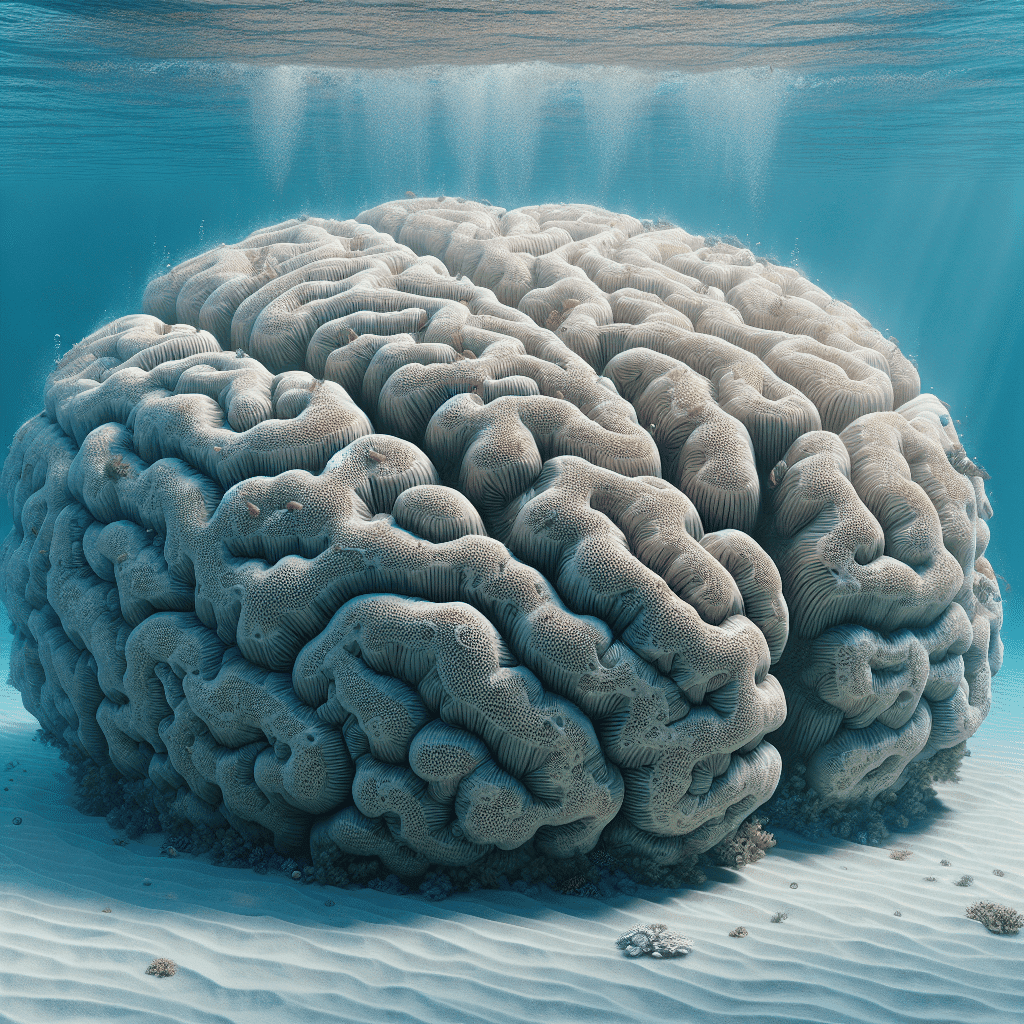Exploring Bubble Corals
Characteristics of Bubble Corals
I find bubble corals, or Plerogyra sinuosa, to be a fascinating addition to any reef tank. These large-polyp stony (LPS) corals are tough and resilient, making them suitable for novice reefkeepers. One of the remarkable traits of bubble corals is their ability to recover from disturbances. For instance, if they tumble down rocks, they can re-expand their vesicles within hours without showing signs of damage (TFH Magazine).
Bubble corals feature distinctive, bubble-like vesicles that can add a unique aesthetic to your tank. They thrive in low to medium water flow and prefer to be placed on the sand bed or low rockwork, where they can securely expand their vesicles. It’s essential to keep them away from other corals due to their aggressive sting and short sweeper tentacles that become active at night.
Types of Bubble Corals
In the world of bubble corals, there are a few varieties worth mentioning. While the most common is Plerogyra sinuosa, there are other related species that can be found in the hobby. However, I usually focus on the primary type due to its popularity and ease of care.
| Bubble Coral Type | Scientific Name | Description |
|---|---|---|
| Common Bubble Coral | Plerogyra sinuosa | Known for its large, bubble-like vesicles and resilience. Great for beginners. |
| Other Varieties | Various | Less common but may be available in specialized aquariums. |
I’ve noticed that bubble corals appreciate occasional feeding, especially with mysid or brine shrimp. They tend to grow more rapidly with regular feeding, which I find enhances their beauty and health (TFH Magazine).
If you’re interested in expanding your knowledge about different coral types, consider exploring brain coral, hammer coral, and torch coral, as they all have unique characteristics that can complement your reef tank.
Care Guide for Bubble Corals
Taking care of bubble corals can be a rewarding experience for any reef tank enthusiast. Here’s how I manage their placement, feeding, and water quality to ensure they thrive.
Placement and Location
I always place my bubble corals on the sand bed, ensuring they are under a light intensity of about 100-150 PAR. They can also go on low rock work if they’re flat and secure. It’s crucial to keep in mind that bubble corals have an aggressive sting and display long sweeper tentacles at night, which can sting nearby neighbors. For this reason, I make sure they don’t come into direct contact with other corals (Fragbox, TFH Magazine). Additionally, these corals thrive in low to medium water flow, which helps keep their vesicles clean.
| Placement Tips | Details |
|---|---|
| Ideal Location | Sand bed or low rock work |
| Light Intensity (PAR) | 100-150 |
| Water Flow | Low to medium |
| Aggressiveness | Can sting neighboring corals |
Feeding Bubble Corals
Feeding bubble corals is another enjoyable aspect of their care. They have a healthy appetite for small pieces of fish or shrimp, which makes feeding them straightforward. I usually offer food every few days. However, I always take care to avoid damaging their sensitive tissues during feeding. It’s a good practice to feed them in low light to minimize stress (Seaunseen).
| Feeding Schedule | Frequency |
|---|---|
| Recommended Food | Small fish or shrimp |
| Feeding Frequency | Every few days |
| Best Time to Feed | During low light |
Water Quality for Bubble Corals
Maintaining high water quality is essential for the health of my bubble corals. I ensure that the water parameters are stable, with gentle water flow and low to moderate lighting. When introducing bright lighting, I do it gradually to allow the corals to acclimate properly. Regular water testing helps me keep track of parameters such as pH, salinity, and ammonia levels, which are crucial for the well-being of corals (Who Gives a Fish).
| Water Quality Parameters | Ideal Range |
|---|---|
| pH Level | 8.1 – 8.4 |
| Salinity | 1.023 – 1.025 SG |
| Ammonia | 0 ppm |
| Water Flow | Gentle |
By following these guidelines on placement, feeding, and water quality, I’ve been able to keep my bubble corals healthy and thriving in my reef tank. For more information on coral care, check out my articles on corals and specific coral types like torch coral and mushroom coral.
Maintenance Tips for Bubble Corals
Keeping bubble corals healthy and thriving in my reef tank requires some attention and care. Here are some essential tips for monitoring their growth, ensuring proper lighting, and preventing diseases.
Monitoring Health and Growth
Bubble corals are generally resilient and can recover from minor mishaps or rough handling. For example, if a bubble coral tumbles down the rockwork, it can re-expand its vesicles within hours without showing signs of damage (TFH Magazine). However, I still keep an eye on a few key indicators to make sure they’re doing well:
| Health Indicator | What to Look For |
|---|---|
| Vesicle Expansion | Healthy bubble corals should have fully expanded vesicles. |
| Color | Vibrant colors indicate good health; dull colors can signal stress. |
| Tissue Integrity | Check for any tissue recession or damage. |
Regularly observing these factors helps me catch any issues early.
Lighting Requirements
Bubble corals thrive under moderate lighting. I prefer using LED lights that simulate natural daylight because they provide the right spectrum for coral growth without overheating the tank. Here’s a quick guide on lighting:
| Light Type | Recommended Intensity |
|---|---|
| LED | 50-75 PAR (Photosynthetically Active Radiation) |
| T5 Fluorescent | Moderate (similar to LED) |
| Metal Halide | Lower intensity to avoid overheating |
I make sure to place my bubble coral where it gets enough light but not too much direct exposure, as this can cause stress and damage.
Preventing Diseases
Bubble corals are durable but can still face challenges from poor water quality and injuries. I focus on maintaining stable water parameters and keeping an eye out for potential diseases. Here are some common issues and how I prevent them:
| Issue | Prevention Tips |
|---|---|
| Brown Jelly Infection | Maintain clean water and avoid overfeeding. |
| Tissue Recession | Ensure stable water quality and avoid physical damage. |
| Algae Growth on Skeleton | Regular tank maintenance and good water circulation. |
Regular water changes and monitoring my tank’s parameters help keep my bubble corals in top shape. If I notice any signs of trouble, I act quickly to remedy the situation. For more information on caring for corals, check out our section on corals.
Bubble Coral Varieties
In my journey of exploring bubble corals, I’ve come across some fascinating varieties that are definitely worth highlighting. Two of the most noteworthy types are the Pearl Bubble Coral and Physogyra Lichtensteini. Let’s dive into what makes each of them unique.
Pearl Bubble Coral
The Pearl Bubble Coral, known scientifically as Physogyra lichtensteini, stands out with its fleshy vesicles that create a stunning visual appeal. These bubbles not only look great but also serve a practical purpose; they provide refuge for several marine invertebrates, including shrimp, during the day. At night, the tentacles of this coral extend to capture passing nutrients, making it a fascinating addition to any reef tank.
This species is commonly found in shallow reefs across the Indo-Pacific region, from the Red Sea to the tropical Western Pacific. However, it’s worth noting that Physogyra lichtensteini is often heavily harvested for the aquarium trade, which raises concerns about its sustainability. In fact, conservation programs are underway, aiming to increase and maintain the functional population of this coral in self-sustaining marine habitats, especially in areas like the Philippines and the Maldives (EDGE of Existence).
| Characteristics | Details |
|---|---|
| Common Name | Pearl Bubble Coral |
| Scientific Name | Physogyra lichtensteini |
| Habitat | Shallow reefs in the Indo-Pacific |
| Unique Features | Fleshy vesicles; provides refuge for invertebrates; extends tentacles at night |
Physogyra Lichtensteini
While Physogyra lichtensteini is the scientific name for the Pearl Bubble Coral, it’s worth mentioning that this name encapsulates the variety and its ecological importance. This coral is known to thrive in shallow and turbid reef environments and can rarely reach up to 3 meters in diameter. Its large, round bubbles are not only visually appealing but also play a crucial role in the ecosystem.
Efforts are being made to ensure that this species is economically and ecologically valued and protected, especially in the Maldives. The goal is to safeguard areas with high abundance of Physogyra lichtensteini through well-managed conservation measures over the next few decades (EDGE of Existence).
Incorporating varieties like the Pearl Bubble Coral into my reef tank has not only enhanced its beauty but also contributed to a healthier marine environment. If you’re considering adding corals to your tank, you might also want to explore other options like brain coral, torch coral, or mushroom coral for a more diverse ecosystem.
Sustainability Efforts for Bubble Corals
As a reef tank hobbyist, I understand the importance of sustainability in maintaining healthy ecosystems, especially when it comes to bubble corals. Here are the key initiatives and impacts related to their conservation.
Conservation Programs
Several conservation programs focus on protecting bubble corals and their habitats. For example, the Survival Blueprint for the Action Programme in the Philippines aims to boost and sustain the population of Physogyra lichtensteini (pearl bubble coral) to ensure its ecological role in marine ecosystems over the next 5-10 years. This initiative is crucial for maintaining biodiversity in coral reefs.
Similarly, the Vision for the Maldives coral reefs Action Programme seeks to protect areas with a high abundance of pearl bubble corals over the next 30-50 years. This long-term plan emphasizes both economic and ecological value, ensuring that these corals thrive in their natural habitats (EDGE of Existence).
Aquaculture Initiatives
Aquaculture efforts are also making a significant impact on the sustainability of bubble corals. ORA’s aquaculture farm in the Marshall Islands is cultivating pearl bubble corals in captivity. This approach reduces the demand for wild collection, which is crucial given that over half a billion people rely on coral reefs for livelihood and protection (AlgaeBarn). By employing both sexual and asexual reproduction methods in aquaculture, we contribute to reef restoration and promote healthier ocean ecosystems sustainably.
Impact on Coral Reefs
Coral reefs face numerous threats, including over-harvesting, pollution, climate change, and disease. Unfortunately, many coral species are currently near threatened, emphasizing the need for proactive measures (AlgaeBarn). Protecting bubble corals is essential not only for their survival but also for the overall health of coral reef ecosystems. Healthy coral reefs provide food, coastal protection, and income for millions of people around the globe.
By staying informed about these sustainability efforts and participating in initiatives like aquaculture, I can contribute to the conservation of bubble corals and their habitats. This not only benefits the coral but also helps ensure that future generations can enjoy the beauty and ecological significance of coral reefs.



